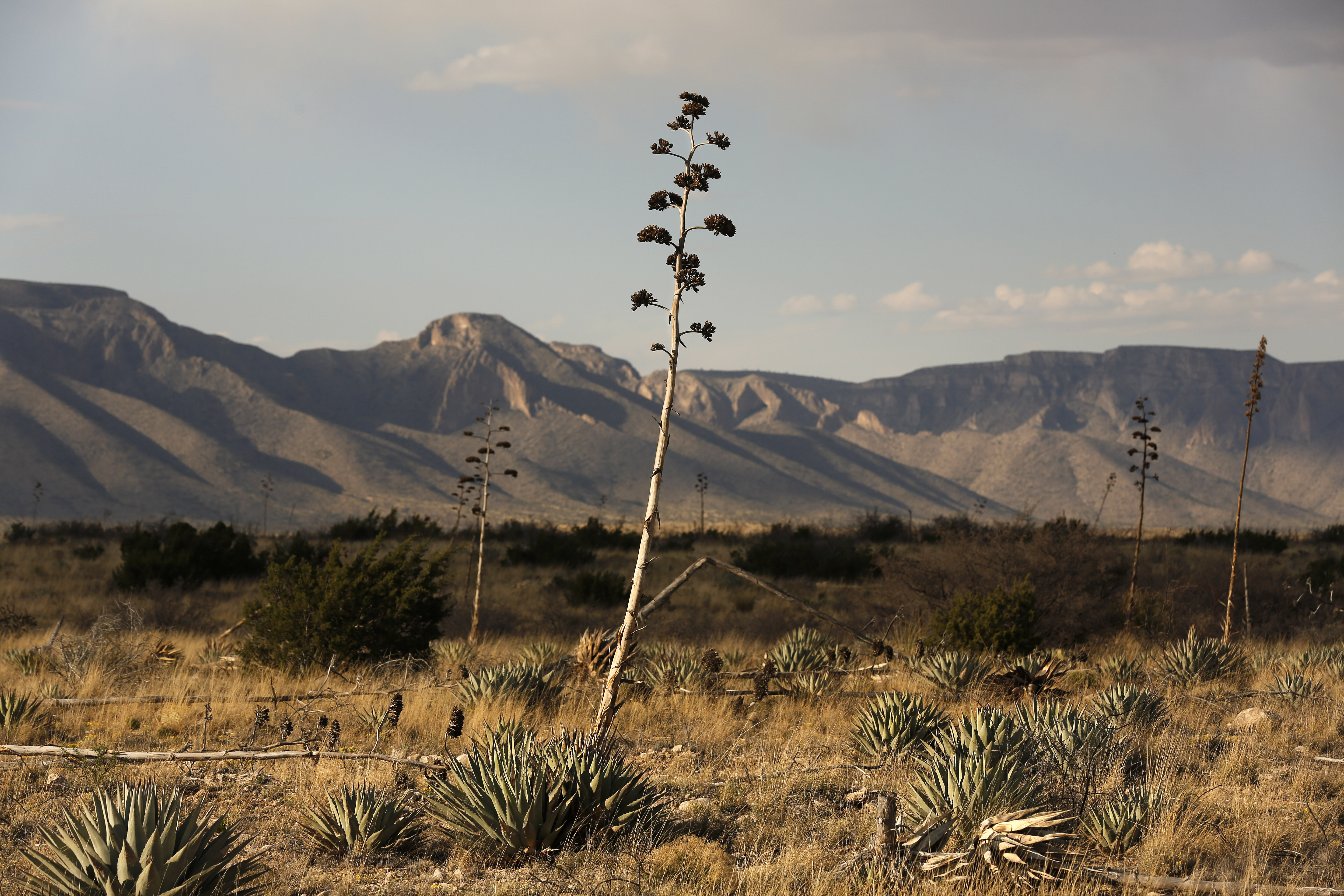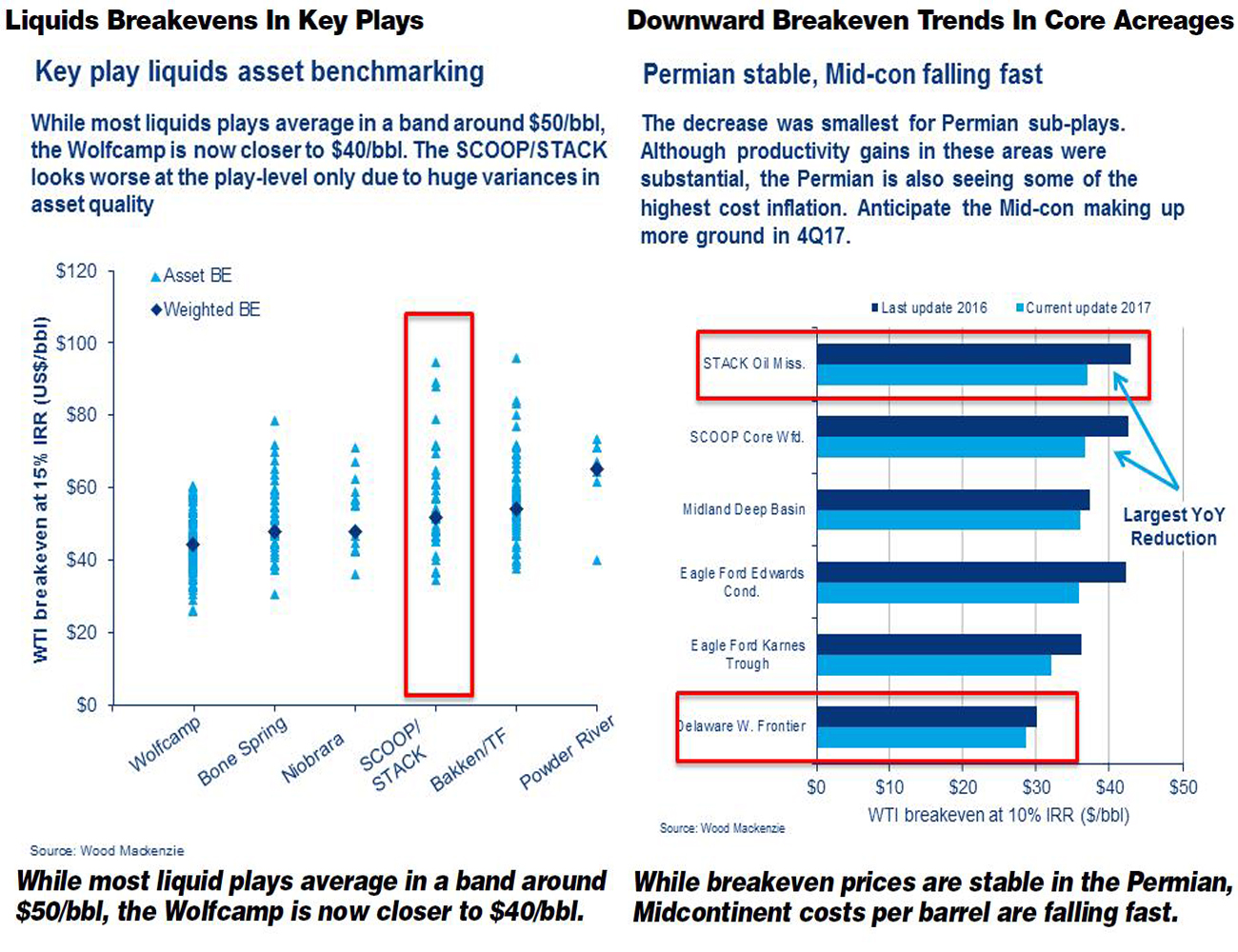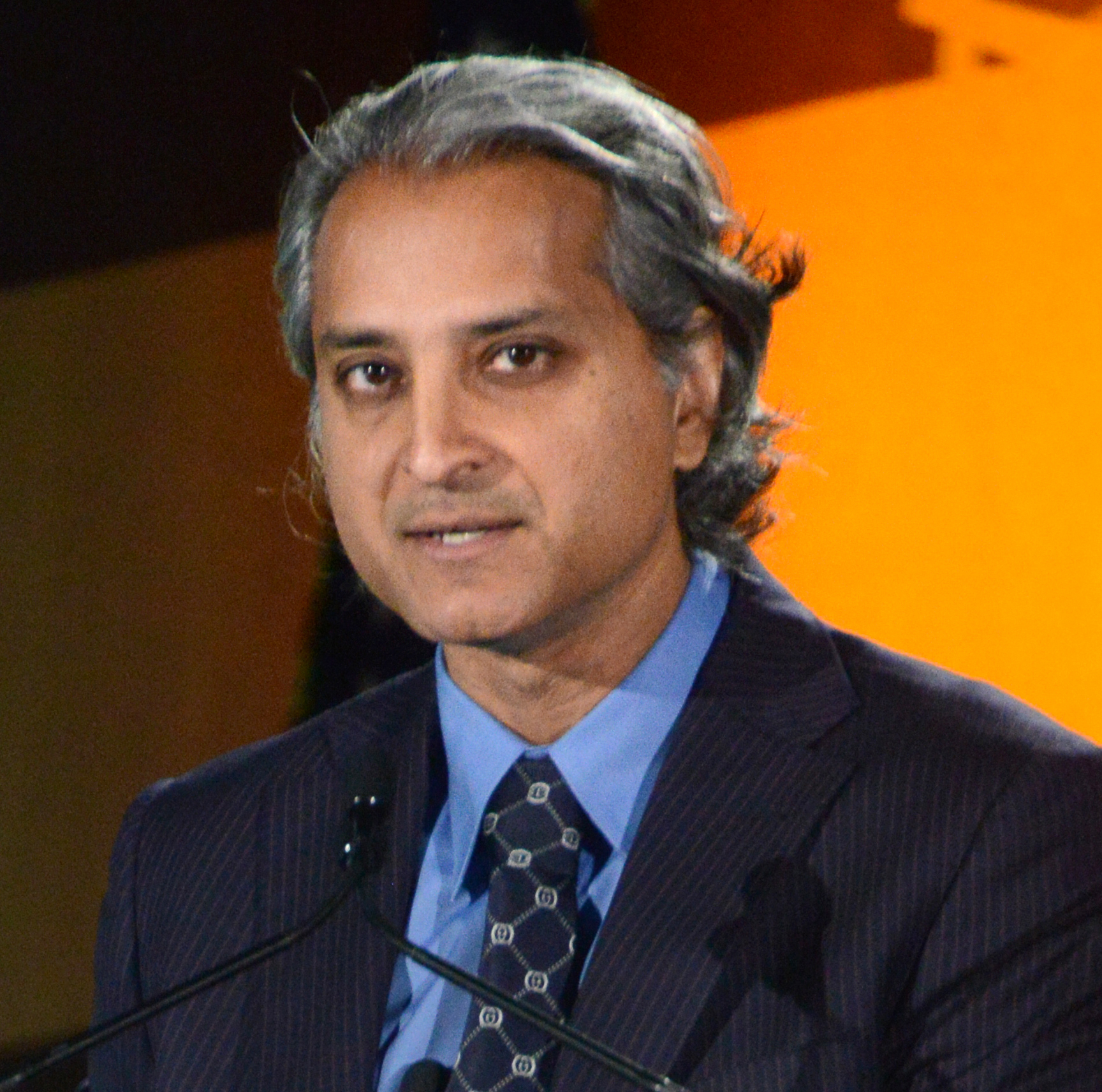
The Delaware Basin’s voluminous production commands attention, but the Stack is catching up, with analysts saying the Oklahoma shale play added 1.5 million acres economic at $50 since 2016.
As competitions go, the Stack play in Oklahoma appears squarely behind the Delaware Basin’s Wolfcamp development. But the full story is, as the saying goes, multilayered.
The Midcontinent’s Stack and Scoop areas have led all plays in the greatest decreases in breakeven prices, while the Permian Basin’s sub-plays have remained flat, Robert Clarke, Wood Mackenzie’s research director for Lower 48 upstream, said at Hart Energy’s DUG Midcontinent conference in Oklahoma City.
Translated into territory, since 2016 the Stack gained 1.5 million acres that are economic at $50 WTI, according Clarke. Wood Mackenzie said that among oil producing wells, about 17,000 locations break even under $50 while 2,800 require $50 or more. In the fourth quarter, the Midcontinent is likely to make more breakeven ground.
The Midcontinent’s Mississippian and Woodford shale areas showed the “biggest year-on-year drop on all the areas we modeled,” Clarke said. “Certainly much more of a drop than what we’ve seen in the western Delaware.”

Infill wells become crucial to the success of the Delaware.
The next step in the evolution of both plays is infill drilling. Success—or failure, meaning lower-volume wells—could significantly change expectations for production from the Delaware and be a boon for the Stack. The dearth of testing the Delaware’s many benches, which drove values for many megadeals in 2016, also leave unanswered questions.
The Delaware’s immediate challenge is its surprisingly high gas-oil ratios, Subash Chandra, managing director and senior equity analyst for Guggenheim Securities LLC, said at the conference.
“Why are they surprises? Because the operators tell us so,” Chandra said. “That means for every barrel of oil, there’s an investment in time and there’s an investment in midstream. That’s a bit more time, a bit more money to deliver the same barrel of oil.”

Wood Mackenzie projects that oil will appreciate by just $1 during the next three years, suggesting WTI will hit $53 per barrel sometime in 2020. (Source: Wood Mackenzie)
In the third quarter, the Street will be watching for a high oil cut from Permian producers.
The rare operators that are cash-flow positive are performing best in the market, followed by companies with the least overspend, Chandra said. Companies with serious overspending are suffering.
“We have gas stocks trading below NAV [net asset value],” Chandra said. “Which means the value of future resources is not being credited by the Street.” The irony is “we haven’t heard anything that the future of oil isn’t the future of gas.”
Wood Mackenzie projects that oil will appreciate by just $1 during the next three years, suggesting WTI will hit $53 per barrel sometime in 2020.
The Stack and the Delaware, in such a price environment, are ideal places to be, if all goes well, Chandra and Clarke said.
Separation anxiety
The real question mark for the Delaware and Stack centers on well density. Can the deep inventory of stacked plays truly be drilled at the spacing E&Ps have promised?
No one is sure what the optimal formula is. “We get it that it’s going to be NPV [net present value] per section, but does it mean that we tolerate infill wells to the parent that” are 20% to 30% inferior to the parent’s productivity, he said.
The Stack and Delaware have different track records, though the Delaware has less public data to offer, Chandra said. Cimarex Energy Co. has large positions in both plays and is working on infill in both, with considerable investment in downhole physics to minimize well-to-well interference, the company has said.
Declines in E&P market values are tied up in the fear that wells will have to be farther apart than first thought, Chandra said.
Cimarex CEO Tom Jorden said at an investment conference in August that being unaware of what’s happening in wellbores isn’t a problem until they move closer together.
“If you get it right and stimulate effectively along the borehole and keep that stimulation close the borehole, you can put those wells very close together,” Jorden said.
But miscalculations can mean wells start to corrupt one another even at distance of 1,500 feet.
The Cimarex viewpoint is that variability in its Stack results is far greater than variability in the Delaware, Chandra said.
He examined 22 pilot wells in the Delaware and Stack. Half of the infill wells underperformed the parent.
“That suggests to me that, as we get to increased density, it’s going to be a bigger challenge to deliver” production expectations, he said. “So where we get to is the Midcontinent is a step behind the Delaware. And it could be the tightness of the rock, the variability of the rock.”
Not all Stack wells are equally challenged. Tests by Continental Resources Inc. in the upper and middle Meramec showed good results in an overpressured area at 1,000-foot spacing, Chandra added. But normal pressure areas need more attention and Stack players need to demonstrate that multiple benches can be developed.

But the challenge in normally pressured areas is to demonstrate good results even in tight spacing, Chandra said, adding “we need to crack the 1,000-foot lateral” as well as demonstrating that multiple benches can be developed.
The Delaware, too, has to prove its locations and its many benches. “It’s not good enough to show a pyramid of 14 zones and say, ‘Give us credit,’” Chandra said. “That was ‘so 2016.’ In 2018, it’s ‘Get it, convert it and show us that these locations actually exist.’ And where that battle is prominently set up … in the Delaware because that’s where many billions in transactions happened.”
The Delaware's immediate challenge is gas-oil ratios, which have so far been surprises, said Subash Chandra, managing director and senior equity analyst at Guggenheim Securities LLC.
Cimarex’s results are promising. In Culberson County, Texas, the company has drilled five 10,000-foot infill wells that have surpassed the EUR of parent wells in two landing zones.
Not all E&Ps are equal, however: Clarke suggested that the rub for the Delaware is that many of its best wells may have already been drilled.
Empty nesters
If the Delaware is approaching a production wall perhaps 18 months out, the Stack would benefit greatly.
Clarke said the Delaware has been the beneficiary of intense, rapid data capture. Everything in the field, from vendor performance to decline curves are analyzed daily, allowing operators to re-rank their entire inventory “in a matter of minutes in the cloud,” he said.
The precision of detailed reservoir modeling could mean production gains in the Delaware, which have been explosive, could also be misleading, Clarke said. “What if the outsized production gains were actually better geology not better completions?”
If that’s the case, the quality—and spacing—of infill wells becomes more acutely felt. “There are lots of forecasts that show the Permian up and to the right forever. History shows us that doesn’t happen,” Clarke said.
The history of shale plays to date have mirrored the rise of empires: an appetite for expansion fuels territorial conquest, rivals are consolidated and the play enters maturity.
“Every shale play has a massive forecast the first few years. It seems like the first few years are easy,” Clarke said. “But, then, something happens. It’s very hard to predict what that is.”
The tug of war, Clarke said, is whether technological advancement or bountiful geology that rapidly increased production in the Wolfcamp. Both camps see either extreme highs or a rapid drop-off in production.
“Reality is somewhere in the middle,” Clarke said.
The technology camp sees the upside for Delaware EURs to swell to 3 million barrels of oil equivalent. The Wolfcamp is early in its development, so the learning curve is particularly long, Clarke said.
The geology viewpoint: Better reservoir modeling took on a new role.
“We believe that acreage high-grading was actually well high-grading. There’s a chance that the best wells have already been drilled,” Clarke said.
In such a scenario, infill wells become crucial to the success of the Delaware.
“If the wells are 30% smaller—and we’re not to that point in the Midcontinent—all of a sudden the assets you’re working could be a lot more competitive,” Clarke said, adding that “Stack assets in particular are showing massive improvements in breakevens.”
Still, Chandra said companies in both prestige plays face trouble if their financial houses aren’t put in order.
Will work For $50’
The oil industry, even in lucrative plays such as the Delaware and Stack, finds itself stuck in a price stalemate. During the downturn, companies went two years without significant drilling activity. Transactions, particularly in the Delaware Basin, were evaluated on location counts based on horizontal and vertical spacing.
“Now you take a year of excess and that is where we’re going to an export model as a safety valve for our production,” Chandra said. “All of a sudden, free cash flow is important.”
The empirical correlation Chandra found is that regardless of other factors, stock performance is universally tied to free cash flow and lower leverage. Chandra expected the trend to reverse, yet through August “that relationship actually deepened,” he said.
“Those that were outspending the least were absolutely outperforming everybody else.”
For E&Ps in the Stack and Delaware—and all other plays—the least common denominator for success appears to be a $50-per-barrel price. “Fifty-dollar oil matters a lot for the next years,” Clarke said.
By 2021, non-OPEC decline rates will be a driving force in total supply volumes. For now, short-term factors have frozen supply reductions at 5%, Clarke said.
Declines are fixed, in part, because of the industry’s talent for implementing “self-help measures” to boost cash flow—particularly maximizing output by fine-tuning production. The result is Lower 48 volumes that have held steady.
Companies, including majors, are also reducing capex and directing more money to short-cycle projects with the highest returns.
Longer term, declines are being kept in check through so-called “zero-decline” assets, such as oil sands and Brazil’s deepwater pre-salt play, Clarke said. Production rates from mid-life and early-life assets have a growing share of production—rising to 30% in 2020 from 6% in 2010. Mature field declines average about 9% during that period.
Still, for the first time, Wood Mackenzie’s models predict that half of the remaining undrilled tight-oil resources in the Lower 48 are economic in $50 environment. “And you really don’t need $50 a barrel for some of the best acres you work. They compete on breakevens,” Clarke said.

Chandra said companies need to recognize that investors want tighter ships, at least for now. “The peril is clear and present,” he said. “We see it the stock performance, we see it in the variance in stocks. We see it in the lack of correlation with commodity prices.”
The Midcontinent's Mississippian and Woodford shale areas showed the "biggest year-on-year drop on all the areas we modeled," said Robert Clarke, Wood Mackenzie research director for Lower 48 upstream.
For companies in the Delaware it’s time to put numbers on the scoreboard. “Really, the Delaware companies have to show a lot more infill pilots,” Chandra said. “At what point does the Street lose patience with 14 landing zones when, in the next three- to five-year period they will only test two of them or three of them?”
Midcontinent stocks, at the same time, have overcorrected—giving the Delaware an even higher bar to clear.
The Delaware’s phenomenal success the past couple of years may ultimately drive investors back to the Midcontinent, Clarke said. In 2016 the Delaware could seemingly do no wrong; today, transactions no longer lift stocks.
“Now, that’s dropped to a negative,” Clarke said.
In July, QEP Resources Inc. reported plans to purchase acreage in the Midland Basin for a Tudor, Pickering, Holt & Co. estimated $51,000 a net acre. The following trading day , QEP shares fell 14% . TPH analysts reported, “The market’s No. 1 concern has been around QEP potentially paying up for another Permian deal, and the company did just that.”

Recommended Reading
Pembina Closes $290MM Deal for Stake in Whitecap’s NatGas Facility
2025-01-02 - Pembina Gas Infrastructure closed a CA$420 million transaction to acquire interests in Whitecap Resources’ natural gas processing facility in Alberta, Canada.
Nabors SPAC, e2Companies $1B Merger to Take On-Site Powergen Public
2025-02-12 - Nabors Industries’ blank check company will merge with e2Companies at a time when oilfield service companies are increasingly seeking on-site power solutions for E&Ps in the oil patch.
DNO to Buy Sval Energi for $450MM, Quadruple North Sea Output
2025-03-07 - Norwegian oil and gas producer DNO ASA will acquire Sval Energi Group AS’ shares from private equity firm HitecVision.
Diamondback Acquires Permian’s Double Eagle IV for $4.1B
2025-02-18 - Diamondback Energy has agreed to acquire EnCap Investments-backed Double Eagle IV for approximately 6.9 million shares of Diamondback and $3 billion in cash.
Obsidian to Sell Cardium Assets to InPlay Oil for US$225MM
2025-02-19 - Calgary, Alberta-based Obsidian Energy is divesting operated assets in the Cardium to InPlay Oil for CA$320 million in cash, equity and asset interests. The company will retain its non-operated holdings in the Pembina Cardium Unit #11.
Comments
Add new comment
This conversation is moderated according to Hart Energy community rules. Please read the rules before joining the discussion. If you’re experiencing any technical problems, please contact our customer care team.






